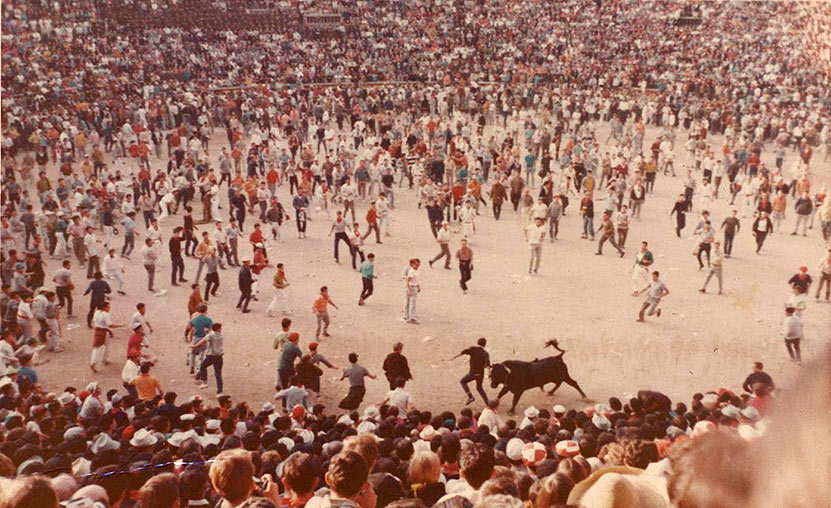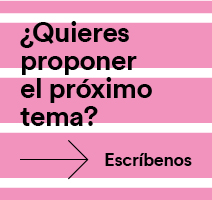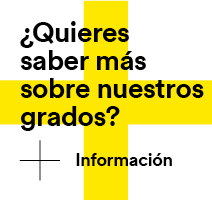Give your opinion
Synopsis of July: the Non-Sanfermines

Here is a synopsis of the July festivities in Pamplona, by Jairo Císcar,
student 2nd year History student and International Office: the lack of economic profit,
the non-acceptance of visitors, the opportunity to return to the traditional fiesta...
"This is the perfect moment to open a profound debate discussion in Navarrese society about what our fiestas are like and what we want them to be like.
about what our fiestas are like and what we want them to be like".

Pamplona, Spain, July, 1968. Running with the bull.
Photo deceased relative of Infrogmation, inherited and scanned by Infrogmation.
Wikipedia
The 14th of July has arrived and with it, as every year, the city is once again calm. But this is not like that. Almost any other year, this could be the first sentence in a regional newspaper headline. However, this year we have ended the second half of July with concern, the atmosphere is grade rarefied. It could be that, quite simply, we have reached the 14th of July with a record 13 million people infected by the Covid-19 pandemic and, as Pamplonians, we have ended our particular No-Sanfermines. How strange it was not to get up to see the running of the bulls; how strange not to dress "in the street" and not in red and white. We did not wait until 23h. to marvel at the fireworks; the "jotas" did not resound during the San Fermin procession. At final, there was no joy and happiness after the chupinazo.
It has been repeated many times during the pandemic that we were living in a nightmare from which we will sooner or later emerge. It is true, we will come out, but it is not a nightmare. This is reality. For the first time since the Civil War, our city's main festival has not been celebrated - or even officially begun. It is important at this point to stress the beginning, since in the 20th century we have two other suspensions, carried out when the festivities had already begun. The first of these was in the turbulent year 1978, following the death of Germán Rodríguez, in the course of fierce altercations. More recently, on 13 July 1997, they were cancelled in the face of popular clamour (except from the Peñas, which will be discussed later) not to continue the fiestas after the murder of Miguel Ángel Blanco by the terrorist group ETA. If we make a historical comparison with other periods of pandemics such as cholera in the 19th century or the misnamed Spanish Flu of 1918, in no case were the events suspended, which demonstrates the seriousness of the status.
agreement And, in view of the seriousness of the situation at the time, the Mayor's Office of Pamplona took the decision of fail, on 21 April, to suspend the fiestas. This was a controversial decision, as it could not have been otherwise, following on from other major fiestas that had been suspended due to Covid-19. It started with the fallas, which began but did not reach the Cremá, and from there the hecatomb: April fair; Easter processions; the Rocío; San Isidro... these are just a few of the thousands of festivities that have had to be cancelled or postponed due to the current status . We are not alone in the impact of this alteration of our festive tradition, which is at the very core of our being.
In any case, they have all been wise decisions; taken to protect public health, with life taking precedence over all other interests. Because there is no doubt that the suspension of these fiestas has had a terrible impact and has had many negative consequences. In the case of Pamplona, the cancellation of San Fermín has meant the loss of some 150 million euros, especially in the hotel and catering sector. More than a loss we should speak of a "non-profit", but after the shops and catering establishments were closed during practically the entire State of Alarm, this has been a terrible tragedy. Many bars and restaurants depended on San Fermín to make ends meet and now it will be very difficult for them to continue. Another of the associated problems is the loss of credit and international fame. It is well known that we owe the furore towards the Sanfermines from all over the world to Fiesta, the first novel by Ernest Hemingway, Pulitzer and Nobel Prize winner for Literature. The American was the precursor and motivator of a character without whom we cannot understand the modern San Fermin: the guiri. I believe that Spain has been singled out to the international public as a country that has failed miserably during the pandemic. However, there is good news, hard but real: there are countries that have done even worse, among them the places of origin par excellence of the average guiri. Be that as it may, the Consistory is faced with the titanic task of trying to reverse the damage caused by the Non-Sanfermines during the next ones, which will be more welcome than ever.
Just as I am aware of the terrible consequences of the cancellation, I believe that it has also been an opportunity to think about our model fiesta, about the fiestas we have and the fiestas we want. Since its internationalization, the Sanfermines have experienced an uncontrolled boom, going from being a festival in a provincial capital to being visited by 1.5 million people. This lack of control has brought with it the scenes to which we are, unfortunately, so accustomed (such as the uncontrolled drunkenness, the selfies during the running of the bulls...), and other terrible scenes to which we are not so accustomed. Traditions are being lost, or are becoming so overcrowded that they are becoming impossible. The City Council has already had to introduce a capacity control system along the route of the encierro due to the masses of runners, many of them inexperienced. Pamplona, its Sanfermines, has much more to offer. That is why the attitude of certain "peñas" (supporters' clubs) who reproached the mayor for holding the San Fermin mass (with capacity control and health measures) when they were not allowed to implement a programme of popular fiestas, is so shocking. It is time to focus on the origin of the fiesta and what it commemorates, in this case the martyrdom of San Fermín. Logically, I understand that for many people the mass is not the central event of our fiestas, but it is their origin, a symbol. With a view to next year, the mayor's office should organise a Sanfermines that goes back to the origins, to tradition. How nice it would be if, after so many years, a Riau Riau Riau could be celebrated with the Corporation, without sectarian altercations. The coronavirus has only accelerated the trends already present in our society: an economic crisis that was already brewing; the total implementation of the internet in our lives; it has even shown up the flaws in our welfare system. We are therefore facing a new era, a new Sanfermines in the post-covid era.
Before concluding, there is an important criticism to be made. It is understandable that after the confinement there is a desire to party, to enjoy oneself and to laugh. But despite the exemplary behaviour of the vast majority of the population, we have seen images that tilt the balance even more in favour of the necessity of the suspension. Streets and small squares crowded with people without the slightest measure of protection; discos and bars open with people getting drunk in close proximity without even seeing a mask; large groups of people... We may all pay dearly for this at a time of strong outbreaks all over the country. The first outbreak has already occurred at a traditional lunch, despite the good initiative of many bars to make sacrifices and close on 6 and 7 July so as not to give rise to contagions. One is left with the feeling that it is precisely this year's party-goers who understand the fiesta the least. It has been decided to enjoy and experience the Sanfermines of 2021 as never before. But we will not be able to forget the hundreds of Navarrese people, especially the elderly, who have died in the pandemic. For the people who taught us about San Fermín which they lived with enthusiasm and emotion for so many years. The next ones must be lived for them.
These Non-Sanfermines have been a clash with reality. The reality of how much we need our fiestas, a very interesting anthropological and sociological phenomenon, and the reality of their problems and deficiencies. It is the perfect moment to open a profound debate discussion in Navarrese society about what our fiestas are like and what we want them to be like. Under no circumstances are we going to come out of this status stronger, but we are going to come out of it different. We must work from the whole of society to make a positive difference. This pandemic has revealed to so many people a reality, that of death, which can only be overcome by life. So let us live the future Sanfermines and in the meantime, let us help in the joint effort to celebrate them.







